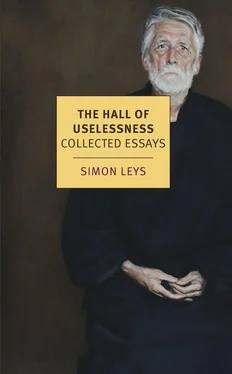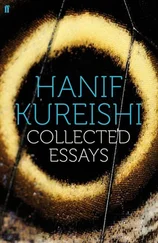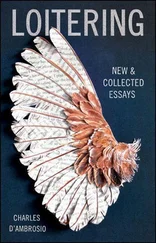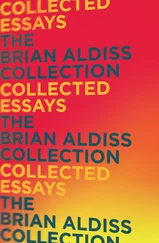Finally, in parallel with the observations made earlier on the spatial dimension of the poetical language, we should also note the time dimension that is expressed in a supremely sophisticated form of Chinese painting, the horizontal scroll ( shoujuan or changjuan ). The horizontal scroll has a physical structure that is identical to that of an archaic book; it cannot be hung, it can only be viewed on a table, through a progressive “reading” process — one hand unrolling one end of the scroll as the other hand rolls up the other end (in this way the viewer can himself select an infinite number of compositions, depending on which segments of the scroll he chooses to isolate as he pursues this scanning process). The eye is being led along the scroll, following an imaginary journey. Pictorial composition unfolds in time , like a poem or a piece of music; it starts with an overture, develops in a succession of movements, now slow, now quick, provides restful intervals, builds up tensions, reaches a climax, concludes with a finale.
COMMUNION WITH THE WORLD
Painters and poets are associated with the cosmic creation. Artistic creation participates in the dynamism of the universe. Through his artistic activity a gentleman becomes both imitator of, and collaborator with, the Creator.[9] Hence, the poet Li He (790–816) could say:
The poet’s brush completes the universal creation:
It is not Heaven’s achievement.
Painters and art theoreticians expressed a similar idea, using practically the same words. Zhang Yanyuan (810?–880?) wrote: “Painting brings the finishing touch to the work of the universal Creator.” It should be noted that in the West many artists reached similar conclusions. For them, however, these were empirical or intuitive observations; unlike their Chinese counterparts, they did not have the possibility to link such reflections to a cosmological system. To borrow an example close to home, I quote A.D. Hope’s definition of poetry:
I have very little faith, as a professional critic of literature, in most of the descriptions or definitions of poetry on which the various schools depend. “The imitation of Nature,” “the overflow of powerful emotions,” a “criticism of life”—well, yes and no: none of them seem to me a satisfactory basis of criticism.
As a poet, I find them exasperating. I know of no definition of the nature and function of poetry that satisfied me better than… the view of poetry as a celebration, the celebration of the world by the creation of something that adds to and completes the order of Nature.[10]
It would be extremely easy to translate this last sentence into Chinese; in China, poets, painters and aesthetes have never stopped making this same statement for the last 1,500 years!
In Chinese poetry, communion with the universe is expressed by various means. We should first mention the unique resources the Chinese language affords poets (we already have alluded to it): the blurry fluidity of syntax and morphology that allows a permanent confusion between subject and object and establishes a sort of porosity, or permeability, between the poet and the surrounding world. A classical example can be found in the first two verses of Meng Haoran’s (689–740) “Spring Morning”:
Spring-time sleep is not aware of dawn;
Singing birds are heard everywhere…
Who is the sleeper? His person is nowhere described or defined — is it I or he or she? The poem suggests a depth of slumber in which the conscious self drifts and dissolves amid confused perceptions of dawn; singing birds vaguely heard in this sleep become the objects of a perception without subject.
A similar effect can be found in one of Wang Wei’s most often quoted poems; here, moreover, the world is being personified — the natural surroundings become an active partner. These verses are often rendered in a way that, without being flatly wrong, considerably weakens the flavour of the poem:
In the empty mountains, no one is seen;
Yet, voices are being heard…
Actually, the poem literally says:
Empty mountain sees no one,
Only hears voices…
Quite naturally, it is with a poet such as Li Bai, deeply imbued with Daoist mysticism, that this personification of all things, this dialogue with the universe acquires full intensity and exuberance. As the poet identifies himself with the thing he contemplates, the subject eventually vanishes, totally absorbed into the object: perfect communion is achieved. We see this in the short poem “On Contemplating Mount Jingting”:
All birds have flown away high in the sky;
One lazy cloud drifts alone.
Without tiring, I look at Mount Jingting, Mount Jingting looks at me;
Finally, there remains only Mount Jingting.
(Li Bai is a poet who can associate with mountains and rivers; he converses with the sun and the stars, as you and I chat with our old friends; he drinks at the banquet of the planets, he rides on the tails of comets. For instance, if one night there is no one with whom to share his bottle of wine, he improvises at once a little party with three guests — himself, the moon and his own shadow — and this lively drinking bout ends with an appointment for another gathering next spring, in the Milky Way…)
For the painters, the identification of the subject with the object assumes an even greater importance: nothing should come between the painter and the thing he observes. Su Dongpo expressed this most eloquently as he was praising the bamboos painted by his friend Wen Tong: if the latter could achieve natural perfection in his art, it was because he had no more need to look at bamboos when painting them, as he himself had become a bamboo .
In order better to appreciate all the implications of such an attitude, it might be useful, by contrast, to refer back for a moment to our own familiar world. In Sartre’s Nausea —a good example of Western consciousness pushed to its paroxysm — there are two objects whose sight provokes in Roquentin a feeling of existential absurdity so acute that it results in actual retching: a pebble polished by the sea, and an oddly twisted tree root. It is interesting to note that, for Chinese aesthetes, it was precisely such types of objects that could actually induce ecstasy —in fact, they were sought by connoisseurs and collectors even more avidly than the masterpieces of artists.
In order to dominate the natural world, Western man cut himself off from it. His aggressive, heroic and conquering attitude towards the environment can be seen, for instance, in the art of classical gardens (every civilisation always reveals its vision of the world in its gardens). Look at Versailles, where we see nature being distorted, bound, raped, cut and remoulded to conform to a purely human design; geometric plans are forced upon it, in complete disregard of its original essence. In such a rigorously anthropocentric perspective, any natural form, any spontaneous pattern that is not man-made and whose enigmatic complexity owes nothing to the human mind appears immediately threatening. Its irreducible and perplexing autonomy limits and challenges man’s empire.
The Chinese, on the contrary, renounced domination of nature to remain in a state of communion with it (today, of course, is another story: the West, having reached the end of the road, belatedly discovers ecology and makes frantic attempts to negotiate some form of reconciliation with the natural environment, whereas China adopts with uncritical enthusiasm some of the most disastrous of our earlier attitudes). In complete contrast with Roquentin, Homo occidentalis extremus , who vomits in front of a stone whose grain and shape would have provoked utter bliss in a Chinese connoisseur, one thinks at once of the exemplary gesture of Mi Fu (1051–1107), one of the most admirable and typical exponents of Chinese aestheticism at its climax. Mi, having reached the seat of his new posting in the provincial administration, put on his court attire, but instead of first paying a courtesy call to the local prefect, he went to present his respects to a rock that was famous for its fantastic shape (even today, Mi Fu Bowing to the Stone remains a subject very popular with painters). Needless to say, this spectacular initiative proved costly for his official career. Yet, by this very gesture, he made it clear for generations to come that, beyond all social hierarchies and conventions, there exists another set of priorities that cannot suffer any compromise. The strangely shaped rock, whose forms had not been carved by human hands, presented in its profile and its patina a direct imprint of the cosmic Creator; for this reason, it also constituted a supreme model and criterion in any creative undertaking. Painters are the privileged interpreters who can decipher and translate the universal consciousness that is written on rocks and clouds, in the twists of branches and roots, in the veins of the wood, in the billowing of mists and waves.
Читать дальше












